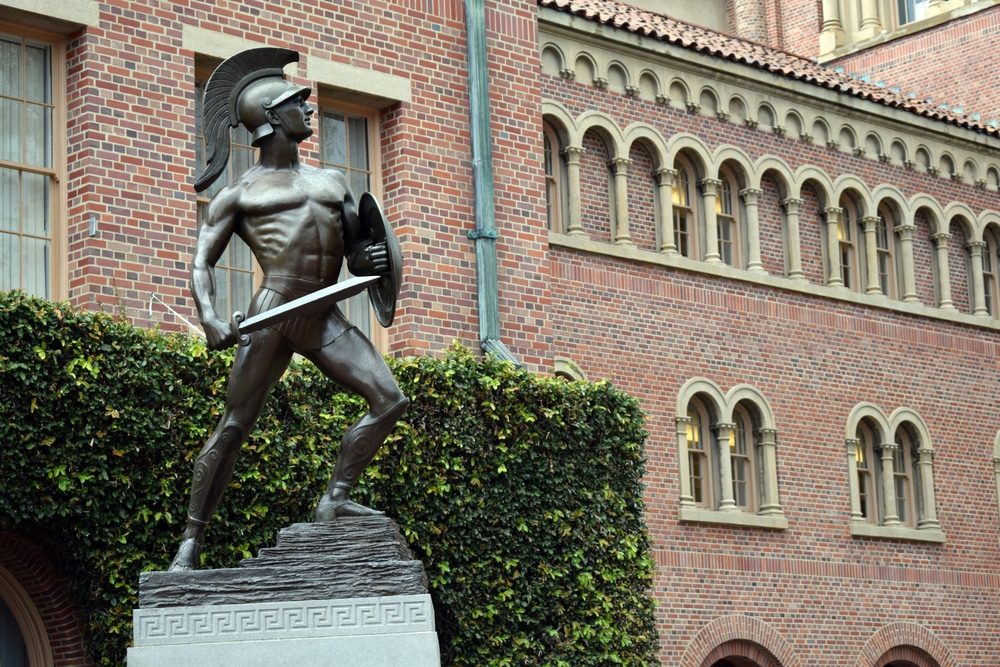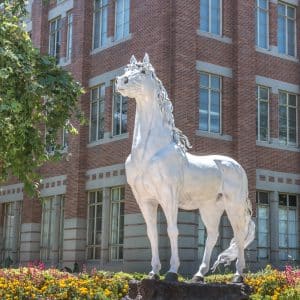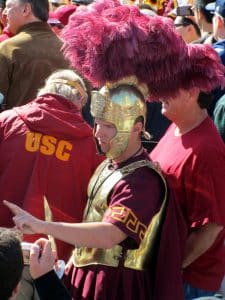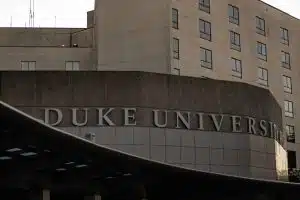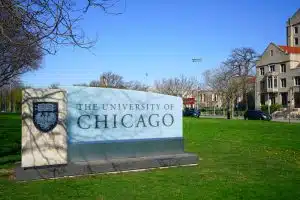USC’s Official Mascot
The University of Southern California (USC) is not just renowned for its academic excellence and vibrant campus life; it’s also home to one of the most iconic symbols in collegiate sports. Traveler, USC’s official mascot, is more than just a horse that graces during games.
It’s the embodiment of the Trojan spirit. A spirit that resonates with students, alumni, and fans alike. The majestic white horse, ridden by a gallant Trojan warrior, has become synonymous with USC’s identity.This article delves into the rich history and significance of Traveler, exploring what makes it a lasting symbol of USC’s heritage.
What Makes Traveler a Symbol of USC?
Traveler, USC’s official mascot, is not merely a figure that appears at sporting events; it’s a profound representation of the university’s values and traditions. The name “Traveler” itself conveys a sense of journey, adventure, and exploration, reflecting the university’s commitment to discovery and excellence.
The sight of Traveler galloping across the field, with the crowd roaring in unison, creates a unique and electrifying atmosphere that unites the USC community. It’s a symbol that transcends generations, connecting past, present, and future Trojans in a shared sense of pride and belonging.
The Historical Significance of Traveler
The historical significance of Traveler, USC’s official mascot, can be traced back to 1961 when the first Traveler made its debut at a USC football game. Since then, the tradition has continued, with different horses taking up the mantle, each contributing to the legacy of Traveler.
The choice of a white horse, often associated with purity, nobility, and strength, was no mere coincidence. It was a deliberate selection that aligned with the values and aspirations of the university.
Over the decades, Traveler has become a fixture at USC events, a living testament to the university’s rich history and enduring traditions.
The Connection Between Traveler and the University’s Identity
Traveler’s connection to USC’s identity goes beyond its role as USC’s official mascot. It’s a symbol that encapsulates the essence of what it means to be a Trojan.
The majestic appearance of Traveler, coupled with the warrior’s courage and determination, mirrors the university’s pursuit of excellence in academics, athletics, and community engagement.
Traveler’s presence at games and events is not just a spectacle; it’s a reminder of the university’s core values and a celebration of the Trojan spirit. This connection has solidified Traveler’s place in the hearts of the USC community, making it a timeless and cherished symbol that continues to inspire.
Who Was the First Traveler, and How Did the Tradition Begin?
The tradition of Traveler, USC’s official mascot, began with an extraordinary horse named Traveler I, who made his debut in 1961. Richard Saukko, the owner and rider, was inspired to introduce a horse as a mascot after observing a similar tradition at other universities.
Saukko purchased a stunning white horse and adorned it with regal Trojan attire. The first appearance of Traveler at a USC football game was met with overwhelming enthusiasm, and the tradition was born.
From that moment on, Traveler became an integral part of USC’s culture, a symbol of pride and unity that continues to captivate the hearts of Trojans to this day.
The Inception of Traveler as USC’s mascot
The inception of Traveler as USC’s official mascot was a carefully orchestrated endeavor that sought to capture the essence of the Trojan spirit. Saukko’s vision was to create a living symbol that would resonate with the university’s values and traditions.
The choice of a horse was not arbitrary; it was a deliberate decision that drew on historical connections to the Trojans of ancient times. The introduction of Traveler at USC was more than just a spectacle; it was a statement of identity, a declaration of the university’s heritage, and a celebration of its enduring legacy.
The Breed and Characteristics of the Original Horse
Traveler I, the original horse that became USC’s official mascot, was an Andalusian horse known for its grace, strength, and beauty. The breed is renowned for its intelligence and temperament, making it an ideal choice for the role.
Traveler I’s striking white coat and majestic presence were awe-inspiring, capturing the attention and admiration of all who witnessed it. The horse’s physical attributes were not merely aesthetic; they were symbolic of the qualities that USC aspired to embody: excellence, nobility, and resilience.
Traveler I set the standard for all subsequent Travelers, leaving an indelible mark on USC’s history.
The Symbolism Behind the Name “Traveler”
The name “Traveler” carries profound symbolism that extends beyond its role as USC’s official mascot. It represents a journey, a quest for knowledge, and a pursuit of excellence that aligns with USC’s mission.
The name encapsulates the adventurous spirit of the university, reflecting its commitment to exploration, discovery, and growth. It’s a name that speaks to the heart of what it means to be a Trojan, resonating with the university’s core values and aspirations.
The choice of the name “Traveler” was not merely a stylistic decision; it was a thoughtful and meaningful selection that continues to inspire and define the USC community.
How Has Traveler Evolved Over the Years?
Traveler, USC’s official mascot, has undergone a fascinating evolution over the years, reflecting the growth and transformation of the university itself. From its debut in 1961 to the present day, Traveler has become more than just a symbol at sporting events; it has become a living embodiment of USC’s values and traditions.
The various incarnations of Traveler have each contributed to the rich tapestry of USC’s history, adapting to the changing times while maintaining the core essence of what makes Traveler a beloved icon.
This evolution is evident in the appearance, breed, role, and care of Traveler, each aspect reflecting the university’s commitment to excellence and community.
Changes in the Appearance and Breed of Traveler
Over the decades, there have been changes in the appearance and breed of Traveler, USC’s official mascot. While the original Traveler was an Andalusian horse, subsequent Travelers have included different breeds, each chosen for their unique characteristics and suitability for the role.
The constant has been the majestic white coat, symbolizing purity, nobility, and strength. These changes in appearance and breed have not diminished the significance of Traveler; rather, they have enriched the tradition, allowing it to evolve and adapt while preserving the core symbolism that makes Traveler a lasting symbol of USC’s identity.
The Role of Traveler in Various University Events
Traveler’s role has expanded beyond the football field to become a prominent feature in various university events. As USC’s official mascot, Traveler’s presence is felt at commencement ceremonies, alumni gatherings, and special celebrations, adding a touch of grandeur and tradition to these occasions.
The galloping of Traveler is not just a spectacle; it’s a unifying moment that brings the USC community together, evoking a sense of pride and connection. Traveler’s expanded role in university events reflects the mascot’s significance as a symbol that transcends sports, resonating with all aspects of university life.
The Handlers and Caretakers of Traveler Through Time
The handlers and caretakers of Traveler, USC’s official mascot, play a crucial role in maintaining the tradition and ensuring the well-being of the horse. Over the years, various individuals have taken on this responsibility, each bringing their passion, expertise, and dedication to the role.
The handlers not only guide Traveler during events but also provide daily care, training, and affection. Their commitment to Traveler’s welfare is a testament to the importance of the mascot within the USC community.
The relationship between the handlers and Traveler is a special bond that reflects the university’s values of compassion, excellence, and integrity, making Traveler not just a mascot but a cherished member of the Trojan family.
What Role Does Traveler Play in USC’s Sporting Events?
Traveler, USC’s official mascot, plays a pivotal role in USC’s sporting events, particularly football games. The presence of Traveler is not merely a tradition; it’s an integral part of the game-day experience that adds excitement, grandeur, and a unique sense of identity.
From leading the team onto the field to galloping around the stadium after a touchdown, Traveler’s participation is a spectacle that unites fans and players alike.
The Rituals and Ceremonies Involving Traveler
The rituals and ceremonies involving Traveler, USC’s official mascot, are steeped in tradition and symbolism. From the pre-game procession to the victory lap, each ritual involving Traveler is carefully choreographed to reflect the university’s values and history.
The rider, dressed as a Trojan warrior, and Traveler’s regal appearance are part of a carefully crafted narrative that pays homage to USC’s connection to the ancient Trojans.
These rituals are not mere performances; they are living traditions that connect generations of Trojans, reinforcing the sense of identity and community that defines USC.
Traveler’s Presence at Football Games
At USC football games, Traveler’s presence is a highlight that fans eagerly anticipate. As USC’s official mascot, Traveler’s entrance onto the field is a moment of celebration, a visual representation of the Trojan spirit that sets the tone for the game.
The sight of Traveler galloping around the stadium, mane flowing, and rider’s sword raised high, is a spectacle that captures the essence of USC’s heritage. Whether leading the team onto the field or celebrating a touchdown, Traveler’s participation adds a unique dimension to the game, creating a connection between the past, present, and future of USC’s football legacy.
The Impact of Traveler on Team Spirit and Fan Engagement
Traveler’s impact on team spirit and fan engagement is profound. As USC’s official mascot, Traveler’s presence at games is a rallying point, a symbol that unites players and fans in a shared sense of purpose and pride.
The energy and excitement generated by Traveler’s gallops around the stadium are palpable, lifting the spirits of the team and igniting the passion of the fans. Traveler’s role extends beyond the field; it’s a symbol that fans identify with, a representation of the values and traditions that make USC unique.
The connection between Traveler and the USC community is a testament to the power of symbols to inspire, motivate, and unite, making Traveler an enduring and cherished part of the Trojan experience.
What Makes Traveler a Lasting Symbol of USC’s Heritage?
Traveler, USC’s official mascot, has become a lasting symbol of USC’s heritage, transcending mere entertainment to embody the core values and traditions of the university. The majestic white horse, ridden by a Trojan warrior, resonates with the university’s connection to the ancient Trojans, symbolizing courage, honor, and excellence.
Traveler’s presence at games and events is not just a spectacle; it’s a living tradition that unites generations of Trojans, reflecting the university’s commitment to community, integrity, and achievement. The enduring appeal of Traveler lies in its ability to capture the essence of USC, creating a timeless symbol that continues to inspire and define the Trojan experience.
The Cultural Significance of Traveler Within the University
The cultural significance of Traveler within the university extends beyond its role as USC’s official mascot. Traveler is a symbol that encapsulates the university’s identity, reflecting its heritage, values, and aspirations.
The rituals and ceremonies involving Traveler are not mere performances; they are expressions of USC’s cultural fabric, connecting students, alumni, faculty, and fans in a shared sense of pride and belonging.
Traveler’s presence at various university events, from sporting games to commencement ceremonies, adds a touch of tradition and grandeur, reinforcing the university’s commitment to excellence and community.
Traveler’s cultural significance is a testament to its ability to resonate with the diverse and dynamic USC community, making it a cherished and unifying symbol.
Traveler’s Influence on Other University Mascots
Traveler’s influence extends beyond USC, impacting other university mascots and shaping the way institutions represent themselves. As USC’s official mascot, Traveler’s unique combination of tradition, symbolism, and spectacle has set a standard for mascots across the country.
The careful integration of history, culture, and entertainment in Traveler’s presentation has inspired other universities to explore meaningful connections between their mascots and their institutional identities.
Traveler’s success in resonating with fans, students, and alumni has demonstrated the power of mascots to be more than mere entertainment; they can be profound symbols that reflect and reinforce the values and heritage of an institution.
The influence of Traveler on other university mascots is a testament to its enduring appeal and the innovative approach USC has taken in creating a mascot that transcends the ordinary.
Conclusion
Traveler, USC’s official mascot, is more than just a symbol; it’s a living embodiment of the university’s heritage, values, and community spirit. From its inception in 1961 to its continued presence at games and events, Traveler has become an integral part of the USC experience.
The majestic white horse, ridden by a Trojan warrior, resonates with students, alumni, faculty, and fans alike, creating a unique and unifying connection that transcends generations.
Reflection on the Mascot’s Role in Unifying the USC Community
The role of Traveler in unifying the USC community cannot be overstated. As USC’s official mascot, Traveler’s presence at sporting events, ceremonies, and celebrations creates a shared sense of identity and pride.
The rituals and traditions involving Traveler are not mere entertainment; they are expressions of the university’s cultural fabric, connecting people from diverse backgrounds in a shared Trojan experience.
The sight of Traveler galloping across the field, the sound of the crowd roaring in unison, and the symbolism behind the name and appearance all contribute to a sense of unity and connection that defines the USC community.
Traveler’s role in unifying the USC community is a reflection of the university’s commitment to inclusivity, excellence, and community engagement, making it a symbol that resonates with all who call themselves Trojans.
Final Thoughts
The timeless connection between USC and Traveler, USC’s official mascot, is a story of tradition, innovation, and community. Traveler’s enduring appeal lies in its ability to capture the essence of USC, reflecting its heritage, values, and aspirations.
The connection between USC and Traveler is not just a symbol; it’s a living tradition that continues to inspire and define the Trojan experience. It’s a connection that transcends the ordinary, making Traveler not just a mascot but a cherished member of the Trojan family, a timeless symbol that will continue to captivate the hearts and minds of the USC community for generations to come.
Experience USC school spirit with both The Traveler and Tommy Trojan
If getting into USC is one of your goals, you should seek the advice of specialists who work in college admissions, such as those at AdmissionSight, to boost your chances of acceptance. Perhaps this is your chance to be a part of the school community and meet USC’s official mascot.
Because of its more than a decade of experience supporting students like you in achieving admission to the universities of their first and second choices, AdmissionSight has become the most trusted name in the business of college admissions guidance.
Please contact us as soon as possible so that we can organize an initial consultation, which will be offered at no cost.



